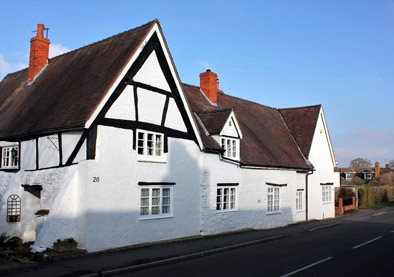Southam has been around as a town, village and community for a very long time, in fact longer than many places in the country including some of our major cities and nearby large population centres like Royal Leamington Spa. It is mentioned in the Domesday Book of 1086 and evidence has been found of the Romans passing through the area. The Romans had an encampment at Chesterton on the Fosse Way but it is unlikely that many of them ventured very far off that well-beaten track.
Given its age it is not surprising that Southam has its share of old buildings and some are easily recognisable as such. These include the splendid Manor House right in the centre of the town carefully restored by Dudley Taylor Pharmacies several years ago, and the Old Mint public house allegedly visited by King Charles right at the start of the Civil War. St James Church is an obvious candidate for the oldest building in the town with archaeological evidence pointing to a church on the site in the 12th century, within a hundred years of the Domesday Book entry. However, the title of this article is “Southam’s Oldest House” so what about domestic properties?
You may be familiar with the story of 1 Abbey Lane which featured in BBC TV’s “Restoration Home” series about ten years ago. 1 Abbey Lane was, and still is, a family home. During the extensive restoration many interesting facts and items were discovered but it was not possible to date the building earlier than around 1600. Repeats of the programme can occasionally be found on BBC iPlayer under the history category. 1 Abbey Lane may well be Southam’s best known old building because the programme has been sold to and shown in many countries around the world (and incidentally Southam Heritage Collection participated in the making of the programme).
Well known though it may be 1 Abbey Lane is not the oldest Southam House – the oldest still standing house, (or part of it,) may be nearly 200 years older. Like 1 Abbey Lane it is situated outside of what we normally think of as the town centre. The building I nominate as Southam’s oldest house is 24/26 Warwick Road. Back in 1989 Dr Nat Alcock, emeritus Reader in Chemistry at Warwick University and expert in mediaeval Cruck Construction, facilitated, along with others, some dendrochronology work that revealed a felling date of the winter of 1418/9 for some of the timbers still in this building. This means some timber parts of these houses are 600 years old, a pretty mind-boggling age for timber beams.
In this age when old houses are often demolished to make way for new development, it is worth mentioning that this highly significant part of Southam’s history was itself almost demolished in the mid-1970s as part of a proposed development project. Fortunately it was saved – partly due to Dr Alcock’s intervention. The photograph shows a modern-day picture of 24/26 Warwick Road with the centre section being the oldest part.
By Bernard Cadogan
Our new exhibition opens in early January. It is all about policing in Southam and is titled: ‘Southam Bobbies’. If you are interested in finding out more about local history, contact Southam Heritage Collection. We are based at Tithe Place, High Street, and normally open on Tuesday, Friday and Saturday mornings from 10am to 12 noon. Contact: 01926 613503 email southamheritage@hotmail.com visit our website www.southamheritage.org and find us on Facebook.


In the 50’s and 60’s I lived at 19 Oxford St which although it had a Victorian facade most of the house was cruck built with large curved trusses standing on stone blocks. The front of the house had been replaced after one of the ‘Fires of Southam’ and to the best of my knowledge the structure is still as it was. Originally the house had been a farm and the outbuildings reflected this and as a farm literally 200 yards from Market Hill it must have been a very early house.
I’ll be going to take a look at 19 Oxford Street tomorrow Malcolm just to get a picture in my mind. By the way, we have a farmhouse in the centre of Harbury to this day – it does seem odd but I suspect it was not that unusual going back 2 – 300 years ago. Bernard